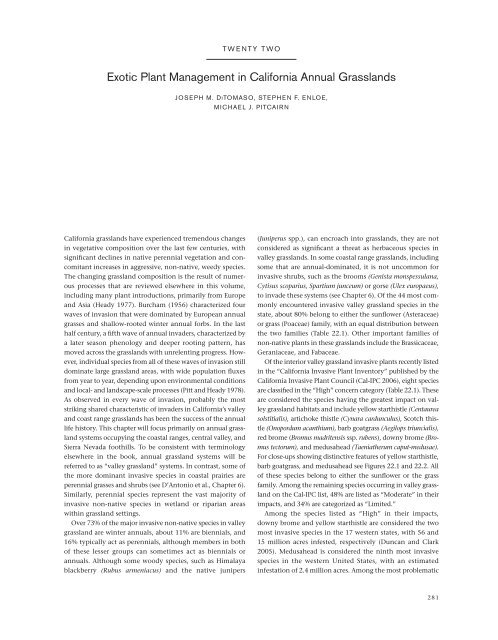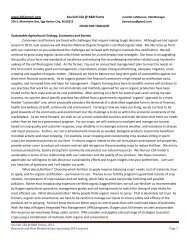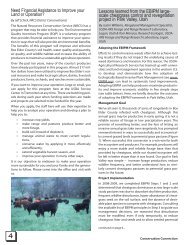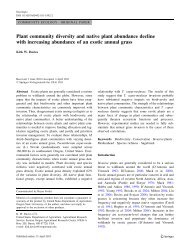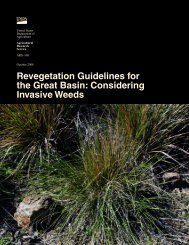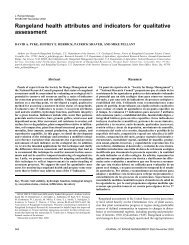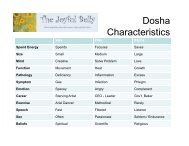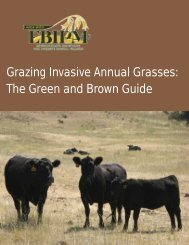Exotic Plant Management in California Annual Grasslands
Exotic Plant Management in California Annual Grasslands
Exotic Plant Management in California Annual Grasslands
Create successful ePaper yourself
Turn your PDF publications into a flip-book with our unique Google optimized e-Paper software.
TWENTY TWO<strong>Exotic</strong> <strong>Plant</strong> <strong>Management</strong> <strong>in</strong> <strong>California</strong> <strong>Annual</strong> <strong>Grasslands</strong>JOSEPH M. DITOMASO, STEPHEN F. ENLOE,MICHAEL J. PITCAIRN<strong>California</strong> grasslands have experienced tremendous changes<strong>in</strong> vegetative composition over the last few centuries, withsignificant decl<strong>in</strong>es <strong>in</strong> native perennial vegetation and concomitant<strong>in</strong>creases <strong>in</strong> aggressive, non-native, weedy species.The chang<strong>in</strong>g grassland composition is the result of numerousprocesses that are reviewed elsewhere <strong>in</strong> this volume,<strong>in</strong>clud<strong>in</strong>g many plant <strong>in</strong>troductions, primarily from Europeand Asia (Heady 1977). Burcham (1956) characterized fourwaves of <strong>in</strong>vasion that were dom<strong>in</strong>ated by European annualgrasses and shallow-rooted w<strong>in</strong>ter annual forbs. In the lasthalf century, a fifth wave of annual <strong>in</strong>vaders, characterized bya later season phenology and deeper root<strong>in</strong>g pattern, hasmoved across the grasslands with unrelent<strong>in</strong>g progress. However,<strong>in</strong>dividual species from all of these waves of <strong>in</strong>vasion stilldom<strong>in</strong>ate large grassland areas, with wide population fluxesfrom year to year, depend<strong>in</strong>g upon environmental conditionsand local- and landscape-scale processes (Pitt and Heady 1978).As observed <strong>in</strong> every wave of <strong>in</strong>vasion, probably the moststrik<strong>in</strong>g shared characteristic of <strong>in</strong>vaders <strong>in</strong> <strong>California</strong>’s valleyand coast range grasslands has been the success of the annuallife history. This chapter will focus primarily on annual grasslandsystems occupy<strong>in</strong>g the coastal ranges, central valley, andSierra Nevada foothills. To be consistent with term<strong>in</strong>ologyelsewhere <strong>in</strong> the book, annual grassland systems will bereferred to as “valley grassland” systems. In contrast, some ofthe more dom<strong>in</strong>ant <strong>in</strong>vasive species <strong>in</strong> coastal prairies areperennial grasses and shrubs (see D’Antonio et al., Chapter 6).Similarly, perennial species represent the vast majority of<strong>in</strong>vasive non-native species <strong>in</strong> wetland or riparian areaswith<strong>in</strong> grassland sett<strong>in</strong>gs.Over 73% of the major <strong>in</strong>vasive non-native species <strong>in</strong> valleygrassland are w<strong>in</strong>ter annuals, about 11% are biennials, and16% typically act as perennials, although members <strong>in</strong> bothof these lesser groups can sometimes act as biennials orannuals. Although some woody species, such as Himalayablackberry (Rubus armeniacus) and the native junipers(Juniperus spp.), can encroach <strong>in</strong>to grasslands, they are notconsidered as significant a threat as herbaceous species <strong>in</strong>valley grasslands. In some coastal range grasslands, <strong>in</strong>clud<strong>in</strong>gsome that are annual-dom<strong>in</strong>ated, it is not uncommon for<strong>in</strong>vasive shrubs, such as the brooms (Genista monspessulana,Cytisus scoparius, Spartium junceum) or gorse (Ulex europaeus),to <strong>in</strong>vade these systems (see Chapter 6). Of the 44 most commonlyencountered <strong>in</strong>vasive valley grassland species <strong>in</strong> thestate, about 80% belong to either the sunflower (Asteraceae)or grass (Poaceae) family, with an equal distribution betweenthe two families (Table 22.1). Other important families ofnon-native plants <strong>in</strong> these grasslands <strong>in</strong>clude the Brassicaceae,Geraniaceae, and Fabaceae.Of the <strong>in</strong>terior valley grassland <strong>in</strong>vasive plants recently listed<strong>in</strong> the “<strong>California</strong> Invasive <strong>Plant</strong> Inventory” published by the<strong>California</strong> Invasive <strong>Plant</strong> Council (Cal-IPC 2006), eight speciesare classified <strong>in</strong> the “High” concern category (Table 22.1). Theseare considered the species hav<strong>in</strong>g the greatest impact on valleygrassland habitats and <strong>in</strong>clude yellow starthistle (Centaureasolstitialis), artichoke thistle (Cynara cardunculus), Scotch thistle(Onopordum acanthium), barb goatgrass (Aegilops triuncialis),red brome (Bromus madritensis ssp. rubens), downy brome (Bromustectorum), and medusahead (Taeniatherum caput-medusae).For close-ups show<strong>in</strong>g dist<strong>in</strong>ctive features of yellow starthistle,barb goatgrass, and medusahead see Figures 22.1 and 22.2. Allof these species belong to either the sunflower or the grassfamily. Among the rema<strong>in</strong><strong>in</strong>g species occurr<strong>in</strong>g <strong>in</strong> valley grasslandon the Cal-IPC list, 48% are listed as “Moderate” <strong>in</strong> theirimpacts, and 34% are categorized as “Limited.”Among the species listed as “High” <strong>in</strong> their impacts,downy brome and yellow starthistle are considered the twomost <strong>in</strong>vasive species <strong>in</strong> the 17 western states, with 56 and15 million acres <strong>in</strong>fested, respectively (Duncan and Clark2005). Medusahead is considered the n<strong>in</strong>th most <strong>in</strong>vasivespecies <strong>in</strong> the western United States, with an estimated<strong>in</strong>festation of 2.4 million acres. Among the most problematic281
TABLE 22.1Most Common Non-native Invasive Species <strong>in</strong> <strong>California</strong> Valley and Foothill <strong>Grasslands</strong>, Includ<strong>in</strong>g their GrowthForm and Cal-IPC ClassificationCommon name Scientific name Family Growth habit Cal-IPC categoryFennel Foeniculum vulgare Apiaceae Perennial HighItalian thistle Carduus pycnocephalus Asteraceae W<strong>in</strong>ter annual ModerateSlenderflower thistle Carduus tenuiflorus Asteraceae W<strong>in</strong>ter annual LimitedWoolly distaff thistle Carthamus lanatus Asteraceae W<strong>in</strong>ter annual Moderate alertPurple starthistle Centaurea calcitrapa Asteraceae <strong>Annual</strong> to perennial ModerateMalta starthistle (tocalote) Centaurea melitensis Asteraceae W<strong>in</strong>ter annual ModerateYellow starthistle Centaurea solstitialis Asteraceae W<strong>in</strong>ter annual HighSquarrose knapweed Centaurea virgata var. Asteraceae Perennial ModeratesquarrosaRush skeletonweed Chondrilla juncea Asteraceae Biennial ModerateBull thistle Cirsium vulgare Asteraceae Biennial ModerateArtichoke thistle Cynara cardunculus Asteraceae Perennial ModerateSmooth catsear Hypochaeris glabra Asteraceae W<strong>in</strong>ter annual LimitedCommon catsear Hypochaeris radicata Asteraceae W<strong>in</strong>ter annual ModerateScotch thistle Onopordum acanthium Asteraceae Biennial HighBristly oxtongue Picris echioides Asteraceae <strong>Annual</strong> or biennial LimitedTansy ragwort Senecio jacobaea Asteraceae Biennial LimitedBlessed milk thistle Silybum marianum Asteraceae W<strong>in</strong>ter annual LimitedDyer’s woad Isatis t<strong>in</strong>ctoria Brassicaceae Biennial Moderate<strong>California</strong> burclover Medicago polymorpha Fabaceae W<strong>in</strong>ter annual LimitedRose clover Trifolium hirtum Fabaceae W<strong>in</strong>ter annual ModerateBroadleaf filaree Erodium botrys Geraniaceae W<strong>in</strong>ter annual Not listedShortfruited filaree Erodium brachycarpum Geraniaceae W<strong>in</strong>ter annual Not listedRedstem filaree Erodium cicutarium Geraniaceae W<strong>in</strong>ter annual LimitedCommon St. Johnswort Hypericum perforatum Hypericaceae Perennial ModerateBarb goatgrass Aegilops triuncialis Poaceae W<strong>in</strong>ter annual HighSilver hairgrass Aira caryophyllea Poaceae W<strong>in</strong>ter annual Not listedSlender oat Avena barbata Poaceae W<strong>in</strong>ter annual ModerateWild oat Avena fatua Poaceae W<strong>in</strong>ter annual ModerateBig quak<strong>in</strong>ggrass Briza maxima Poaceae W<strong>in</strong>ter annual LimitedLittle quak<strong>in</strong>ggrass Briza m<strong>in</strong>or Poaceae W<strong>in</strong>ter annual Not listedRipgut brome Bromus diandrus Poaceae W<strong>in</strong>ter annual ModerateSoft brome Bromus hordeaceus Poaceae W<strong>in</strong>ter annual LimitedRed brome Bromus madritensis Poaceae W<strong>in</strong>ter annual Highssp. rubensDowny brome (cheatgrass) Bromus tectorum Poaceae W<strong>in</strong>ter annual HighHedgehog dogtailgrass Cynosurus ech<strong>in</strong>atus Poaceae W<strong>in</strong>ter annual ModerateOrchardgrass Dactylis glomerata Poaceae Perennial LowTall fescue Festuca arund<strong>in</strong>acea Poaceae Perennial ModerateMediterranean barley Hordeum mar<strong>in</strong>um Poaceae W<strong>in</strong>ter annual ModerateHare, smooth and Hordeum mur<strong>in</strong>um Poaceae W<strong>in</strong>ter annual Moderatewall barleyItalian ryegrass Lolium multiflorum Poaceae W<strong>in</strong>ter annual ModerateMedusahead Taeniatherum Poaceae W<strong>in</strong>ter annual Highcaput-medusaeSquirreltail fescue Vulpia bromoides Poaceae W<strong>in</strong>ter annual Not listedRattail fescue Vulpia myuros Poaceae W<strong>in</strong>ter annual ModerateBellardia Bellaria trixago Scrophulariaceae W<strong>in</strong>ter annual Limitedor biennial
FIGURE 22.1 Close-ups of flowerheads of two common <strong>in</strong>vasive Centaurea species <strong>in</strong> <strong>California</strong>.Left: C. melitensis (tocalote or Malta starthistle). Right: C. solstitialis (yellow starthistle). Note that thesp<strong>in</strong>es on C. solstitialis are approximately twice the length of those found on C. melitensis.<strong>in</strong>vasive plants <strong>in</strong> <strong>California</strong>’s valley grasslands, the two mostcommon species are yellow starthistle and medusahead (seeFigures 22.1, 22.2). Downy brome, despite its widespreadwestern impact, has caused significant problems only <strong>in</strong> thenortheastern (Modoc Plateau) part of the state, so it will notbe discussed further here.ImpactsInvasive non-native plants <strong>in</strong> <strong>California</strong> grasslands can havesignificant ecological and economic impacts. Although amore thorough treatment of ecological impacts can be found<strong>in</strong> Chapter 6, a number of key impacts will be discussed here.S<strong>in</strong>ce the <strong>California</strong> grasslands have historically played amajor role <strong>in</strong> livestock production, weed impacts have oftenbeen strongly associated with that <strong>in</strong>dustry. Impacts <strong>in</strong>clude<strong>in</strong>terference with graz<strong>in</strong>g practices; reductions <strong>in</strong> forageproductivity or quality; <strong>in</strong>creased costs of manag<strong>in</strong>g and produc<strong>in</strong>glivestock; reduced animal weight ga<strong>in</strong>s; reduced qualityof meat, milk, wool, and hides; and livestock poison<strong>in</strong>g.Medusahead, for example, is of low value because of its highsilica content (George 1992). This reduces the forage qualityand makes it less palatable to livestock and wildlife comparedto other forage grasses. In areas heavily <strong>in</strong>fested withmedusahead, livestock carry<strong>in</strong>g capacity can be reduced byas much as 75 to 80% (Major et al. 1960; Hironaka 1961;George 1992). One of the more recent animal issues to cometo light is the impact of many <strong>in</strong>vasive plants on the horse<strong>in</strong>dustry, especially where small acreage development isoccurr<strong>in</strong>g. Invasive forbs such as yellow starthistle, Russianknapweed, houndstongue, and tansy ragwort can result <strong>in</strong>poison<strong>in</strong>g and death to horses when consumed at high levels(Cordy 1954).Direct impacts of grassland weeds on humans and qualityof life <strong>in</strong>clude <strong>in</strong>creased allergens <strong>in</strong> the air, sickness ordeath from <strong>in</strong>advertent consumption of poisonous plants,damage to recreational equipment, and <strong>in</strong>jury or discomfortfrom physical contact with sp<strong>in</strong>y thistles such as milk thistleand yellow starthistle or abrasive parts such as the awnsof ripgut brome (Bromus diandrus). With <strong>in</strong>creased use ofgrasslands for recreational activity, <strong>in</strong>clud<strong>in</strong>g hik<strong>in</strong>g andbik<strong>in</strong>g, direct impacts on humans are now much moreprevalent (DiTomaso 2000).In addition to impacts on humans and animals, many <strong>in</strong>vasiveplants may alter ecosystem structure and functionalprocesses, <strong>in</strong>clud<strong>in</strong>g hydrologic, fire, and nutrient cycles. Structuralchanges <strong>in</strong> <strong>in</strong>vaded plant communities typically causereduced native species richness and diversity and changes <strong>in</strong>canopy structure (Belcher and Wilson 1989; Parmenter andMacMahon 1983; Rikard and Cl<strong>in</strong>e 1980; Wallace et al. 1992).In one study reported on by DeLoach (1991), the number ofplant species present <strong>in</strong> <strong>California</strong> grasslands <strong>in</strong>creased by 35%follow<strong>in</strong>g biological control of common St. Johnswort (Hypericumperforatum). When large scale conversions of vegetationallife history strategies and phenology occur, the potential forfunctional changes to hydrology, nutrient, and fire cycles probably<strong>in</strong>creases. This has been observed with the late-matur<strong>in</strong>g,deeply rooted forb yellow starthistle when it <strong>in</strong>vades the earlymatur<strong>in</strong>g,shallow-rooted annual grass communities. Yellowstarthistle has been shown to deplete soil moisture reservesand alter water cycles <strong>in</strong> annual grasslands (Enloe et al. 2005).This could cause large annual economic losses <strong>in</strong> water conservationcosts <strong>in</strong> <strong>California</strong>. In Siskiyou County, for example,it was estimated that the potential water loss due to yellowstarthistle would be more than 100,000 m 3 , or 26,400,000gallons, per year (Enloe 2002). The depletion of soil moistureEXOTIC PLANT MANAGEMENT 283
widespread problems. While many weeds, such as yellowstarthistle, are well beyond the scope of EDRR <strong>in</strong> <strong>California</strong>,there are still many species to which this approach can beapplied locally and regionally. In grasslands these <strong>in</strong>cludeScotch thistle, woolly distaff thistle, artichoke thistle, andspotted knapweed. EDRR may also be <strong>in</strong>tegrated <strong>in</strong>to adaptivemanagement strategies with little conflict.Mechanical ControlA number of mechanical methods are used to control herbaceousgrassland weeds, <strong>in</strong>clud<strong>in</strong>g hand labor, mow<strong>in</strong>g, andcultivation techniques. In many cases these techniques arenot practical or cost-effective, but there are situations <strong>in</strong>which they can be used very effectively. They also can beused effectively and with little tra<strong>in</strong><strong>in</strong>g for volunteer-basedstewardship programs or “weed pull<strong>in</strong>g days.”Hand LaborHand labor methods for weed control <strong>in</strong> grasslands <strong>in</strong>cludehand pull<strong>in</strong>g and tools such as weed whips, sl<strong>in</strong>g blades,clippers, shovels, hoes, mattocks, and Weed Wrenches.There has been little published research compar<strong>in</strong>g handlabor to other weed control methods <strong>in</strong> the <strong>California</strong> grasslands,so most available <strong>in</strong>formation has been translatedfrom agricultural systems or is anecdotal <strong>in</strong> nature. Handlabor is widely used for controll<strong>in</strong>g small weed patches butis difficult and expensive to use on large <strong>in</strong>festations. Handlabor is also more commonly used where volunteer help isavailable and <strong>in</strong> follow-up control programs where few plantsrema<strong>in</strong> after several years of <strong>in</strong>tensive management (Sheleyet al.1998). The relative success of hand labor <strong>in</strong> grasslandsis dependent upon removal of a plant’s grow<strong>in</strong>g po<strong>in</strong>ts. Forannuals and biennials, sever<strong>in</strong>g the plants below the crown(i.e., cutt<strong>in</strong>g or break<strong>in</strong>g plants off a few <strong>in</strong>ches below the soilsurface) is all that is necessary. For creep<strong>in</strong>g perennials,remov<strong>in</strong>g the vertical and lateral roots or rhizomes is essentialfor success. The difficulty of do<strong>in</strong>g this <strong>in</strong> most soil typesis immense, with the exception of moist, sandy soils. Therefore,hand weed<strong>in</strong>g techniques are typically more effective onannual and biennial species and less effective on perennials,which often regenerate from adventitious buds on deep lateraland vertical roots. <strong>Plant</strong> height is also important, as lowgrow<strong>in</strong>grosettes are generally more difficult to remove byhand pull<strong>in</strong>g than plants with bolted or elongated stems aslong as the soil rema<strong>in</strong>s moist. These factors result <strong>in</strong> optimalcontrol tim<strong>in</strong>g, which is when plants reach the late bolt<strong>in</strong>gto early bud stage before soils become too dry. This tim<strong>in</strong>galso often co<strong>in</strong>cides with the end of the germ<strong>in</strong>ation periodfor many w<strong>in</strong>ter annual weeds that dom<strong>in</strong>ate <strong>California</strong>grasslands. This reduces the potential for new cohorts toemerge follow<strong>in</strong>g the disturbance caused by hand labor.A benefit of hand removal is that desirable species, if present,can be left <strong>in</strong> place. In Mar<strong>in</strong> County, repeated handpull<strong>in</strong>g with a Weed Wrench not only proved to be aneffective method for French and Scotch broom control <strong>in</strong>small <strong>in</strong>festations, but also encouraged native plant recovery(Alexander and D’Antonio 2003a). It was also more effectivethan mow<strong>in</strong>g.Mow<strong>in</strong>g and Clipp<strong>in</strong>gMow<strong>in</strong>g is a common vegetation management techniqueprimarily used along roadsides and right-of-ways throughout<strong>California</strong>. Its ma<strong>in</strong> purposes <strong>in</strong>clude ma<strong>in</strong>ta<strong>in</strong><strong>in</strong>g the safetyrecovery zone or “clear zone,” keep<strong>in</strong>g visibility high, andreduc<strong>in</strong>g fuel loads to prevent wildfires. Mow<strong>in</strong>g has alsobeen used for weed management <strong>in</strong> both the <strong>in</strong>terior andcoastal <strong>California</strong> grasslands. Although not generally effectivefor weed eradication, mow<strong>in</strong>g has primarily been used toreduce seed production of both exotic grasses and forbs, andproper tim<strong>in</strong>g is critical for its effectiveness. Mow<strong>in</strong>g tooearly <strong>in</strong> the spr<strong>in</strong>g <strong>in</strong>creases light penetration without remov<strong>in</strong>ga significant proportion of weed biomass. This generallybenefits weedy species by stimulat<strong>in</strong>g rapid recovery ofgrowth while soil moisture is still abundant. Mow<strong>in</strong>g toolate <strong>in</strong> the summer does not prevent seed production andmay serve to work the seeds down <strong>in</strong>to the seed bank betterand dissem<strong>in</strong>ate weed seeds to new areas.The optimum time for mow<strong>in</strong>g most annual species is <strong>in</strong>the flower<strong>in</strong>g stage before seed development. This generallyresults <strong>in</strong> the greatest reduction of seed production. However,when soil moisture is plentiful follow<strong>in</strong>g mow<strong>in</strong>g, the effectivenessof control may be greatly reduced. For example,mow<strong>in</strong>g diffuse knapweed (Centaurea diffusa) under adequatesoil moisture resulted <strong>in</strong> compensatory growth and ultimatelygreater seed production compared to plants <strong>in</strong> an unmowedarea (Sheley et al. 1999). Although mow<strong>in</strong>g is more oftenused as a tool for control of noxious annual weeds, it can successfullycontrol some biennial and perennial weeds (Benefieldet al. 1999; Tyser and Key 1988). Repeated mow<strong>in</strong>g on perennialbroadleaf species can prevent seed production, reduceroot carbohydrate reserves, and give advantages to desirableperennial grasses.Properly timed mow<strong>in</strong>g has been demonstrated to be asuccessful tool for the control of yellow starthistle (Benefieldet al. 1999). However, the growth form of the plants is criticalfor success. If plant architecture is characterized by profusebasal branch<strong>in</strong>g, then mow<strong>in</strong>g tends to make the growthform prostrate, and the result is limited control. However, ifthe growth form is primarily elongated stems with little basalbranch<strong>in</strong>g, such as those found with<strong>in</strong> dense cover, mow<strong>in</strong>gcan be very effective (Benefield et al. 1999). Consequently,mow<strong>in</strong>g for yellow starthistle control is best employed wherecompetition for light results <strong>in</strong> elongated yellow starthistlestems.Mow<strong>in</strong>g or clipp<strong>in</strong>g for vegetation management has alsobeen shown to shift species composition <strong>in</strong> <strong>California</strong> coastalprairie from exotic annual grasses to exotic forbs (Hayes andHoll 2003b) or mixes of native and exotic forbs (Maron andJefferies 2001). In pastures, mow<strong>in</strong>g may reduce grass canopyEXOTIC PLANT MANAGEMENT 285
TABLE 22.3List of Biological Control Agents Aga<strong>in</strong>st Grassland Weeds, Approved for Release <strong>in</strong> <strong>California</strong>Weed Scientific name Biological control agent Distribution Year of <strong>in</strong>tro Infestation ControlCommon St. Johnswort Hypericum perforatum Agrilus hyperici Established widely 1950 Moderate UnknownChrysol<strong>in</strong>a hyperici Unknown 1945 Unknown UnknownChrysol<strong>in</strong>a quadrigem<strong>in</strong>a Established widely 1946 Heavy ExcellentChrysol<strong>in</strong>a varians No establishment 1952 Absent UnknownZeuxidiplosis giardi Established limited 1950 Light PoorDiffuse knapweed Centaurea diffusa Bangasternus fausti Established widely 1994 Moderate GoodLar<strong>in</strong>us m<strong>in</strong>utus Established widely 1995 Moderate GoodSphenoptera jugoslavica Established widely 1980 Heavy UnknownUrophora aff<strong>in</strong>is Established widely 1976 Light PoorUrophora quadrifasciata Established limited 1990 Slight PoorSpotted knapweed Centaurea maculosa Agapeta zoegana Established limited 1993 Light Poor(C. bieberste<strong>in</strong>ii)Cyphocleonus achates Established limited 1993 Light PoorLar<strong>in</strong>us m<strong>in</strong>utus Established limited 1995 Light GoodTerellia virens Established limited 1995 Light PoorUrophora aff<strong>in</strong>is Established widely 1976 Light PoorUrophora quadrifasciata Established limited 1990 Light PoorSquarrose knapweed Centaurea virgata Bangasternus fausti Established widely 1996 Moderate Excellentvar. squarrosaCyphocleonus achates No establishment 1995 Absent NoneLar<strong>in</strong>us m<strong>in</strong>utus Established widely 1997 Heavy ExcellentSphenoptera jugoslavica Established limited 1998 Moderate FairTerellia virens No establishment 1998 Absent NoneUrophora aff<strong>in</strong>is No establishment 1998 Absent NoneUrophora quadrifasciata Established widely 1998 Light PoorPuncturev<strong>in</strong>e Tribulus terrestris Microlar<strong>in</strong>us lareynii Established widely 1961 Heavy ExcellentMicrolar<strong>in</strong>us lypriformis Established widely 1961 Heavy ExcellentTansy ragwort Senecio jacobaea Longitarsus jacobaea Established widely 1969 Heavy ExcellentPegohylemyia seneciella Established widely 1966 Light PoorTyria jacobaeae Established widely 1959 Light GoodMediterranean sage Salvia aethiopis Phrydiuchus tau Established limited 1976 Light Unknown
permit for release on yellow starthistle <strong>in</strong> <strong>California</strong>. The rustwas orig<strong>in</strong>ally collected from yellow starthistle <strong>in</strong> its nativerange of Turkey <strong>in</strong> 1978 (Woods and Villegas 2004). Pucc<strong>in</strong>iajaceae var. solstitialis is an obligate parasite of yellow starthistleand is associated with the thistle over a wide area, at leastfrom Spa<strong>in</strong> to Turkey (Savile 1970). It completes its life cycleon a s<strong>in</strong>gle host plant and has all five spore forms. It causesnonsystemic foliar <strong>in</strong>fections that can reduce fresh and dryweights of <strong>in</strong>oculated yellow starthistle <strong>in</strong> controlled studies(Bruckart 1989; Shishkoff and Bruckart 1993). Spores, however,may not persist over the w<strong>in</strong>ter.Despite considerable research on host specificity of Pucc<strong>in</strong>iajaceae var. solstitialis and nontarget plant safety at the USDA-Agricultural Research Service (ARS) facility <strong>in</strong> Ft. Detrick,Maryland, little is known about the plant-pathogen <strong>in</strong>teractionunder field conditions, <strong>in</strong>clud<strong>in</strong>g <strong>in</strong>formation on themost effective <strong>in</strong>oculation tim<strong>in</strong>g w<strong>in</strong>dow to maximize <strong>in</strong>fectionrates and foliar damage. Furthermore, while the rust hasbeen shown to reduce root biomass, it is unknown whetherthis is due to a decrease <strong>in</strong> lateral root production or to theability of yellow starthistle to produce deep roots. Such <strong>in</strong>formationmay significantly impact our capability to predictthe effect of the pathogen on yellow starthistle’s ability todevelop tolerance to water stress. Moisture levels have beenshown to correlate directly with seed production. If rootdepth is limited by pathogen stress, this may subsequentlyimpact plant growth, seedhead production, and ultimatelyreproductive output. In addition, noth<strong>in</strong>g is known on howthe Pucc<strong>in</strong>ia rust will <strong>in</strong>teract with the established biologicalcontrol <strong>in</strong>sects or how it will change the competitive abilityof yellow starthistle compared to other grassland vegetationunder different environmental conditions. Results of thesestudies can greatly improve the capacity to predict the potentialeffectiveness of the Pucc<strong>in</strong>ia rust under a number ofabiotic and biotic conditions.Chemical ControlHerbicides are an important method of weed control <strong>in</strong> grasslandsystems. Herbicides can be applied to grasslands by anumber of methods, <strong>in</strong>clud<strong>in</strong>g fixed-w<strong>in</strong>g aircraft, helicopters,ground applicators, backpack sprayers, and rope wickapplicators. Herbicides registered for use <strong>in</strong> grasslands of thewestern United States are listed <strong>in</strong> Table 22.4, along with pert<strong>in</strong>ent<strong>in</strong>formation on each compound. Some of these products,<strong>in</strong>clud<strong>in</strong>g picloram and metsulfuron, are not registered<strong>in</strong> <strong>California</strong>. Of these compounds used <strong>in</strong> grasslands, theaux<strong>in</strong>ic, or growth regulator, herbicides have played the mostimportant role <strong>in</strong> broadleaf weed control.For large-scale use, herbicides are typically considered to bethe most economical option. The most widely used grasslandherbicides <strong>in</strong> <strong>California</strong> are those that have postemergenceactivity (DiTomaso 2000). These <strong>in</strong>clude 2,4-D, triclopyr,dicamba, clopyralid, chlorsulfuron, and glyphosate. Ofthese, clopyralid, 2,4-D, triclopyr, and dicamba are growthregulator herbicides that are selective on broadleaf speciesand have little activity on grasses. Clopyralid also has excellentpreemergence activity and is highly effective for control ofyellow starthistle and other members of the Asteraceae. However,it may have some negative impacts on some native plantswith<strong>in</strong> the Asteraceae, Fabaceae, Polygonaceae, and Apiaceaeand short-term impacts on Violaceae (Reever Morghan et al.2003). Chlorsulfuron is an am<strong>in</strong>o acid <strong>in</strong>hibitor and is alsovery effective on most broadleaf species, particularly membersof the mustard (Brassicaceae) and figwort (Scrophulariaceae)families. It has both preemergence and postemergence activityon most species, but only preemergence activity on yellowstarthistle. Like the growth regulator compounds, chlorsulfuronis fairly safe on most grasses. Glyphosate is a nonselectivearomatic am<strong>in</strong>o acid <strong>in</strong>hibitor and provides excellentcontrol of annual and perennial grasses and broadleaf weeds,but it will also damage desirable plants.Am<strong>in</strong>opyralid is a new growth regulator herbicide registered<strong>in</strong> <strong>California</strong> <strong>in</strong> 2006. It has about three times the activity ofclopyralid on yellow starthistle. In addition to its activityaga<strong>in</strong>st yellow starthistle, am<strong>in</strong>opyralid has a broader spectrumof selectivity and has also been shown to be very effectiveon knapweeds, many other thistles, and fiddlenecks(Ams<strong>in</strong>ckia spp.) (Kyser et al. 2007). Both products will <strong>in</strong>jurenative legumes dur<strong>in</strong>g the grow<strong>in</strong>g season, but some can beused safely when treatments are made after senescence or dur<strong>in</strong>gthe dormant phase of perennial legumes. Another newlyregistered herbicide (not yet <strong>in</strong> <strong>California</strong>), imazapic, hasproven to be very effective on medusahead, downy brome,ripgut brome, barb goatgrass, and other annual grasses, withoutsignificantly <strong>in</strong>jur<strong>in</strong>g seedl<strong>in</strong>gs of many native perennialgrass or broadleaf species (Kyser et al. 2007).Tim<strong>in</strong>g of herbicide applications can determ<strong>in</strong>e the effectivenessof the treatment. For yellow starthistle control, thebest tim<strong>in</strong>g for application of clopyralid and am<strong>in</strong>opyralidseems to be between December and the end of March,depend<strong>in</strong>g on the location (DiTomaso et al. 1999b). Fall orspr<strong>in</strong>g applications of imazapic can be effective for the controlof annual grasses, depend<strong>in</strong>g on the location. In areaswith snowpack, spr<strong>in</strong>g applications may be more desirable,but <strong>in</strong> typical Central Valley or foothill conditions, fall applicationshave proven successful. For perennials, tim<strong>in</strong>g ofapplication can depend on the herbicide. Chlorsulfuron cancontrol perennial species with spr<strong>in</strong>g, summer, or fall treatments(Drake and Whitson 1989; Whitson et al. 1989; Younget al. 1998), whereas glyphosate is best applied <strong>in</strong> spr<strong>in</strong>g,when <strong>in</strong>vasive plants are at the late bud to early flower<strong>in</strong>gstages (Waterhouse and Mahoney 1983; Young et al. 1998).Herbicides are generally applied as broadcast treatmentsover the entire field or directed (spot) applications to controlearly weed <strong>in</strong>vasions or to prevent the spread of small <strong>in</strong>festations.However, it is also possible to achieve selective controlof a particular weed with otherwise nonselective or relativelynonselective postemergence herbicides by employ<strong>in</strong>g a ropewick or wick applicator. These can be either hand-held orvehicle-mounted boom wipers. As a benefit, this applicationmethod reduces the potential for herbicide drift and290 POLICY AND MANAGEMENT
TABLE 22.4Commonly Used Herbicides for Grassland Invasive Weed ControlRegistered <strong>in</strong>Common name Trade name Mode of action Weed spectrum Soil residual <strong>California</strong> Effective tim<strong>in</strong>g2,4-DWeedar ® ,Weedone ® andmany othersBroadleaf speciesLess than 2 weeksYesPostemergence only, fromseedl<strong>in</strong>g to bolt<strong>in</strong>gAm<strong>in</strong>opyralidMilestone ®Growth regulatorCerta<strong>in</strong> broadleaf families(between clopyralid andpicloram)Full seasonYesEffective both pre- andpostemergence; applied fall,w<strong>in</strong>ter, or spr<strong>in</strong>gChlorsulfuronTelar ®Am<strong>in</strong>o acid synthesis<strong>in</strong>hibitorMa<strong>in</strong>ly broadleaf speciesAt least 2 monthsYesPreemergence onlyClopyralidGrowth regulatorTransl<strong>in</strong>e TM Growth regulatorRemedy ®Certa<strong>in</strong> broadleaf families(e.g., Asteraceae, Fabaceae,Apiaceae, Solanaceae,Polygonaceae)Most of the seasonYesEffective both pre- andpostemergence; applied fall,w<strong>in</strong>ter or spr<strong>in</strong>gDicambaBanvel ® ,Vanquish ®Growth regulatorBroadleaf speciesLess than 1 monthYesPostemergence only, fromseedl<strong>in</strong>g to bolt<strong>in</strong>gGlyphosateRoundup ® , andothersAm<strong>in</strong>o acid synthesis<strong>in</strong>hibitorNonselectiveNoneYesPostemergence only, fromseedl<strong>in</strong>g to early flower<strong>in</strong>gImazapicPlateau ®Am<strong>in</strong>o acidsynthesis <strong>in</strong>hibitorNonselective, but best onannual grassesFull seasonRegistrationexpected <strong>in</strong> 2007or 2008Ma<strong>in</strong>ly as a preemergencetreatment, postemergencecontrol with seedl<strong>in</strong>gs orrosettesMetsulfuronEscort ®Am<strong>in</strong>o acid synthesis<strong>in</strong>hibitorBroadleaf speciesAt least 2 monthsNoFairly effective; preemergenceonlyPicloramTordon TMGrowth regulatorBroadleaf species, weak onmustardsUp to 3 yearsNoEffective both pre- andpostemergence; applied fall,w<strong>in</strong>ter or spr<strong>in</strong>gTriclopyrGarlon ® ,Growth regulatorBroadleaf speciesLess than 1 monthYesPostemergence only, good onseedl<strong>in</strong>gs, fair on matureplants
<strong>in</strong>jury to adjacent sensitive agricultural crops and can beused to selectively control <strong>in</strong>vasive species around vernalpools, streams, and other bodies of water, or <strong>in</strong> areas with rareand endangered species or other desirable plants.Residual thatch can <strong>in</strong>fluence the effectiveness of herbicideswith preemergence activity. Some herbicides, such asimazapic, can adsorb to stand<strong>in</strong>g thatch or other dried debrison the soil surface, thus reduc<strong>in</strong>g the effectiveness of theapplication. However, this does not appear to be a characteristicof am<strong>in</strong>opyralid or clopyralid (DiTomaso et al.1999b).Although herbicides are effective for the control of <strong>in</strong>vasivegrassland weeds, they generally do not provide longtermcontrol of weeds when used alone (Bussan and Dyer1999). In the absence of a healthy plant community composedof desirable species, one noxious weed may be replacedby another equally undesirable species <strong>in</strong>sensitive to the herbicidetreatment (DiTomaso 2000). Thus, herbicides <strong>in</strong> grasslandsare best used as part of an <strong>in</strong>tegrated weed managementsystem.Cultural ControlGraz<strong>in</strong>gGraz<strong>in</strong>g can be an effective way of manag<strong>in</strong>g undesirablespecies <strong>in</strong> some grasslands both <strong>in</strong> <strong>California</strong> and elsewhere(see also Hunts<strong>in</strong>ger et al., Chapter 20). The effectivenessdepends on the plant species present, the type of grazer used,and the tim<strong>in</strong>g and <strong>in</strong>tensity of the graz<strong>in</strong>g program. Undersome conditions graz<strong>in</strong>g can <strong>in</strong>crease undesirable nonnativespecies, or other less palatable or poisonous species. Intensivegraz<strong>in</strong>g can also disturb soil and enhance weed seed germ<strong>in</strong>ation,reduce competition from more desirable species, and<strong>in</strong>crease soil compaction (Elmore 1992). So, if graz<strong>in</strong>g is to beused, it must be used judiciously with prescriptions designedfor <strong>in</strong>dividual sites.Successful <strong>in</strong>vasive weed management can also depend onthe type of grazer and tim<strong>in</strong>g of graz<strong>in</strong>g. For example, theforag<strong>in</strong>g behaviors of both cattle and goats are conducive tothe management of yellow starthistle when plants are grazedat the bolt<strong>in</strong>g stage, whereas only goats are effective whenplants are <strong>in</strong> the sp<strong>in</strong>y stages of growth (Thomsen et al.1993). The ideal time to graze is when the noxious species aremost susceptible to defoliation or when the impact on thedesirable vegetation is m<strong>in</strong>imal (Kennett et al. 1992).Stock<strong>in</strong>g rates of livestock can also be adjusted to maximize<strong>in</strong>vasive plant management. Lower stock<strong>in</strong>g rates willgenerally allow livestock to graze preferred plants and avoidless palatable species. If the <strong>in</strong>vasive species is preferred, thenlower stock<strong>in</strong>g rates can be effective. In most cases, however,grasslands with low cattle stock<strong>in</strong>g rates have higher weed<strong>in</strong>festations compared to areas that are more <strong>in</strong>tensivelygrazed. Higher stock<strong>in</strong>g densities can m<strong>in</strong>imize the grazers’ability to avoid less palatable <strong>in</strong>vasive weed species. This canlead to a more uniform composition of plant species andmore balanced competitive relationships among native and<strong>in</strong>vasive species (Olson 1999).High-<strong>in</strong>tensity, short-duration graz<strong>in</strong>g, practiced on arotational basis, is a management system widely adopted <strong>in</strong>other countries (DiTomaso 2002) that is becom<strong>in</strong>g <strong>in</strong>creas<strong>in</strong>glyrecommended <strong>in</strong> <strong>California</strong> grasslands (see Jacksonand Bartolome, Chapter 17). This can be logistically difficultand generally requires electric fenc<strong>in</strong>g to keep animals conf<strong>in</strong>edto a specific area. Once grassland has been <strong>in</strong>tensivelygrazed, it is allowed to recover for about a month beforebe<strong>in</strong>g grazed aga<strong>in</strong>. This system usually leads to more uniformforage use (<strong>in</strong>clud<strong>in</strong>g many weeds) by the grazer. Inmany cases, this method has been shown to provide muchbetter control of specific weeds than season-long livestockgraz<strong>in</strong>g (see review by DiTomaso 2000).High-<strong>in</strong>tensity graz<strong>in</strong>g of both cattle and sheep has beentested experimentally for the control of medusahead. Georgeet al. (1989a) found that two years of <strong>in</strong>tensive graz<strong>in</strong>g withcattle significantly reduced medusahead from 45% of thetotal species composition to only 10%. In another studyus<strong>in</strong>g sheep, <strong>in</strong>tensive mid-spr<strong>in</strong>g graz<strong>in</strong>g (April/May)reduced medusahead by greater than 80% the follow<strong>in</strong>g year(DiTomaso, Kyser and Doran, unpublished data).Prescribed Burn<strong>in</strong>gThere has been <strong>in</strong>creas<strong>in</strong>g <strong>in</strong>terest <strong>in</strong> the use of prescribed firefor vegetation management <strong>in</strong> recent years, <strong>in</strong>clud<strong>in</strong>g <strong>in</strong><strong>California</strong> grasslands (see Re<strong>in</strong>er, Chapter 18). Purposes forprescribed burn<strong>in</strong>g have <strong>in</strong>cluded <strong>in</strong>vasive weed control,thatch removal, nutrient release from dead, dried plant matter,and stimulation of early growth of desirable species <strong>in</strong> thespr<strong>in</strong>g. However, while most of these purposes are bestaccomplished with late fall burns, burn<strong>in</strong>g designed to control<strong>in</strong>vasive species <strong>in</strong> <strong>California</strong> grasslands generally needsto be conducted <strong>in</strong> late spr<strong>in</strong>g or summer. Unfortunately,this tim<strong>in</strong>g co<strong>in</strong>cides with the period when there is high riskof fire escapes. Moreover, air quality problems and liabilityissues can also present a problem when burns are conductednear populated areas. In areas where biological control agentsare present, burn<strong>in</strong>g may cause damage to these <strong>in</strong>sect populations.In some areas, burn<strong>in</strong>g can lead to rapid <strong>in</strong>vasionby other undesirable postfire colonizers with w<strong>in</strong>d-dispersedseeds, particularly members of the sunflower family.The ma<strong>in</strong> objective of us<strong>in</strong>g controlled burns for <strong>in</strong>vasiveplant control is to deplete the soil seed bank, destroy seedsthat are on the plant, and prevent sexual reproduction,which would <strong>in</strong> turn replenish soil seed reserves. To successfullycontrol annual species with fire, it is critical to either killplants before their seeds become viable (DiTomaso et al.1999a) or destroy the seeds before they disperse (Allen 1995;Menke 1992). For annual species, burns should be conductedwhen the target plant’s seeds are still undispersed and areexposed to direct flames <strong>in</strong> the canopy, but desirable specieshave dispersed their seeds to the ground. Seeds on the soilsurface are not generally exposed to lethal temperatures <strong>in</strong>292 POLICY AND MANAGEMENT
grassland fires (Sweet 2005). For perennial or herbaceousplants with protected meristems (e.g., rosettes or rhizomes),the burn must be hot enough to damage the vegetative reproductivetissues and prevent resprout<strong>in</strong>g. For this reason, prescribedburn<strong>in</strong>g is rarely effective for the management ofperennials and <strong>in</strong> most cases can stimulate their growth(DiTomaso et al. 1999a). It has, however, been used to reducethe seed bank of French broom with<strong>in</strong> <strong>California</strong> grasslandsett<strong>in</strong>gs (Alexander and D’Antonio 2003b). Fire stimulatesbroom seed germ<strong>in</strong>ation, and the flush of seedl<strong>in</strong>gs is thencut, treated with an herbicide, or reburned prior to plantsbecom<strong>in</strong>g reproductively mature.<strong>Annual</strong> species that are most susceptible to control withprescribed burn<strong>in</strong>g are those that produce seeds after the fireseason beg<strong>in</strong>s, have flower<strong>in</strong>g structures either embeddedwith<strong>in</strong> the fuel bed or exposed to direct flames, and haveshort-lived seed banks. For control of these late-season annualgrasses and forbs, the tim<strong>in</strong>g of the burns is critical. Burns conductedbefore the target species have fully cured their seedsare most effective (Brooks 2001). To be successful, however,f<strong>in</strong>e fuels to carry the fire should not be limit<strong>in</strong>g. However, f<strong>in</strong>efuels are often patchy across landscapes, and the result is amosaic burn pattern that results <strong>in</strong> variable weed control.Invasive grasses with long-awned seeds (e.g., medusahead,downy brome, ripgut brome, red brome, and barb goatgrass)rely on animal dispersal. In many of these species, the seedsrema<strong>in</strong> <strong>in</strong> the <strong>in</strong>florescence longer than most desirablegrasses, and, as a result, they are more susceptible to destructionby the direct heat of burn<strong>in</strong>g (Dahl and Tisdale 1975,Young et al. 1970). Effective control of medusahead with prescribedburn<strong>in</strong>g (more than 90%) was demonstrated as farback as 1953 (Furbush 1953) and has been demonstrated ona number of other occasions (George 1992; McKell et al. 1962;Pollak and Kan 1998; Sharp et al. 1957; Betts 2003; DiTomasoet al., unpublished). However, <strong>in</strong> some cases burn<strong>in</strong>g has notproven successful on medusahead. Young et al. (1972) foundthat repeated annual burn<strong>in</strong>g <strong>in</strong> mid-summer <strong>in</strong>creasedmedusahead <strong>in</strong>festations while decreas<strong>in</strong>g the population ofmore desirable annual grasses. This <strong>in</strong>consistency is probablydue to differences <strong>in</strong> the length of flame exposure and to theheat of the burn. Other <strong>in</strong>vasive long-awned annual grasses,<strong>in</strong>clud<strong>in</strong>g barb goatgrass (DiTomaso et al. 2001; Hopk<strong>in</strong>sonet al. 1999) and ripgut brome (DiTomaso et al. 1999a; Kyserand DiTomaso 2002) have also been controlled with one ormultiple years of burn<strong>in</strong>g, although exception can also befound (A. Lev<strong>in</strong>e and C. D’Antonio, unpublished data). Incontrast, downy brome and red brome are difficult to controlwith burn<strong>in</strong>g because their seedheads beg<strong>in</strong> to shatter and theseeds fall to the soil surface before enough fuel is available(Brooks 2002; Young and Evans 1978).Late season forbs, particularly yellow starthistle, can alsobe controlled by repeated early summer burns (DiTomasoet al. 1999a; Kyser and DiTomaso 2002). Because the seed ofstarthistle survives for more than two years <strong>in</strong> the soil andgerm<strong>in</strong>ation is enhanced by a preced<strong>in</strong>g burn (DiTomasoand Kyser, unpublished data), a s<strong>in</strong>gle year of burn<strong>in</strong>g willnot control an <strong>in</strong>festation. In one case, three consecutive yearsof burn<strong>in</strong>g were required to reduce the yellow starthistleseed bank by 99% (DiTomaso et al. 1999a). In other studies(DiTomaso and Kyser, unpublished data; Miller 2003), <strong>in</strong>tegrat<strong>in</strong>ga first year burn with a second year herbicide treatmentwas the most effective strategy.Like other control strategies, prescribed burn<strong>in</strong>g requires afollow-up program to prevent escaped or isolated plants fromcomplet<strong>in</strong>g their life cycle. Where the seed bank is shortlived,a follow-up program may take only a couple of years;<strong>in</strong> other cases, it may take longer.S<strong>in</strong>ce multiple burns are not usually practical or permitted,and fuel loads may not be sufficient to allow multiple yearburns, <strong>in</strong>tegrated approaches are often more appropriatethan us<strong>in</strong>g burn<strong>in</strong>g as a sole control option.RevegetationThe goal of grassland management should be to improvedegraded communities and make them less susceptible tonoxious weed <strong>in</strong>vasion. Revegetation with desirable andcompetitive plant species is one approach to achiev<strong>in</strong>g longterm,susta<strong>in</strong>able suppression of weed population growth,while provid<strong>in</strong>g high forage production or desirable plantdiversity (Borman et al. 1991; Lym and Tober 1997).The choice of species used <strong>in</strong> a revegetation effort is criticalto its success. Seeded species need to be adapted to the soilconditions, elevation, climate, and precipitation level of thesite (Jacobs et al. 1999). Only a limited number of specieshave proven to be aggressive enough to resist establishmentof problematic <strong>in</strong>vasive species, and the proper species choicevaries depend<strong>in</strong>g on the location and objective. Perennialbunchgrasses are among the most commonly used species forrevegetat<strong>in</strong>g western rangelands and grasslands, and theyhave been shown to reduce the growth and reproduction ofweeds such as yellow starthistle (Lym and Tober 1997; Rochéet al. 1994; Dukes 2001a; Reever Morghan and Rice 2005).Some native broadleaves, <strong>in</strong>clud<strong>in</strong>g Hemizonia congesta, havea similar life cycle to and can suppress the growth of yellowstarthistle (Duke 2001a). Introduced broadleaf species such aslegumes can also be used <strong>in</strong> revegetation programs to suppressrangeland or grassland weeds. For example, Thomsenet al. (1997) and Thomas (1996, 1997) tested several legumespecies for their competitive effect on yellow starthistle.Thomsen et al. (1997) found subterranean clover (Trifoliumsubterraneum) varieties to be the most competitive when comb<strong>in</strong>edwith graz<strong>in</strong>g and mow<strong>in</strong>g, but they did not provideadequate seasonal control of yellow starthistle <strong>in</strong> the absenceof other control options. Thomas (1996, 1997), however,used a comb<strong>in</strong>ation of subterranean clover and/or crimsonclover (Trifolium <strong>in</strong>carnatum) as a cover crop <strong>in</strong> yellowstarthistle–<strong>in</strong>fested pasture. In a completely <strong>in</strong>fested field, hereported an 80–90% reduction <strong>in</strong> yellow starthistle one yearafter plant<strong>in</strong>g with crimson clover. However, use of legumesmay <strong>in</strong>crease soil nitrogen, which can cause other potentiallyundesirable effects (see Dukes and Shaw, Chapter 19).EXOTIC PLANT MANAGEMENT 293
SIDEBAR 22.1CASE STUDIES OF INTEGRATED MANAGEMENT STRATEGIESComb<strong>in</strong>ation of Herbicides and RevegetationAn <strong>in</strong>tegrated approach comb<strong>in</strong><strong>in</strong>g herbicide treatments and perennial grass revegetation was tested <strong>in</strong>a heavily <strong>in</strong>fested yellow starthistle grassland site near Yreka, <strong>California</strong> (Siskiyou County). The goal wasto provide ranchers and land managers with economical and susta<strong>in</strong>able management programs thatmaximized forage production or restored and preserved desired ecosystem functions, <strong>in</strong>clud<strong>in</strong>g reduc<strong>in</strong>gthe susceptibility of their lands to re<strong>in</strong>vasion or <strong>in</strong>vasion by other noxious weeds.In this severely degraded site, a mid-February treatment with glyphosate (one treatment) and clopyralid(one, two, or three annual spr<strong>in</strong>g treatments) was used to provide a w<strong>in</strong>dow of reduced competitionfor the subsequent establishment of pubescent wheatgrass drill-seeded <strong>in</strong> early March (Enloe 2002;Enloe et al. 2005). This seed<strong>in</strong>g tim<strong>in</strong>g, while not appropriate for much of <strong>California</strong>, has been shownto work well for far Northern <strong>California</strong> (Kay and Street 1961), where sufficient ra<strong>in</strong> falls after early Marchto support wheatgrass establishment.The study area was monitored for six years (Enloe et al. 2005). Clopyralid treatment significantlyreduced yellow starthistle, and glyphosate gave control of the annual grasses. This comb<strong>in</strong>ation allowedpubescent wheatgrass seedl<strong>in</strong>gs to establish with a s<strong>in</strong>gle year of treatment. Once pubescent wheatgrassseedl<strong>in</strong>gs survived the first year, additional applications of clopyralid to control the starthistle did notimprove their establishment. In the absence of clopyralid and glyphosate, pubescent wheatgrass establishmentwas very limited.The <strong>in</strong>tegrated approach gave long-term suppression of yellow starthistle and other exotic annualgrasses and forbs over the six year period. Treatments with clopyralid alone (e.g., without seed<strong>in</strong>g ofwheatgrass), gave good control of yellow starthistle, but the plant community <strong>in</strong>itially became dom<strong>in</strong>atedby undesirable annual grasses, particularly downy brome. Downy brome, <strong>in</strong> turn, offered little competitiveresistance to starthistle re<strong>in</strong>vasion, and with<strong>in</strong> a couple of years after the f<strong>in</strong>al clopyralid applicationthis site reverted to yellow starthistle (Enloe et al. 2005).Long-term <strong>Management</strong> Us<strong>in</strong>g Prescribed Burn<strong>in</strong>g and ClopyralidAs was previously discussed, repeated burn<strong>in</strong>g is generally impractical and can negatively impact air qualityas well as compromise establishment of biocontrol agents. The cont<strong>in</strong>uous use of clopyralid can alsohave undesired outcomes. As a result, an <strong>in</strong>tegrated strategy was developed comb<strong>in</strong><strong>in</strong>g clopyralid andprescribed burn<strong>in</strong>g for management of yellow starthistle (DiTomaso et al. 2003). Results of small-scaleplot studies <strong>in</strong>dicate that prescribed burn<strong>in</strong>g stimulated the germ<strong>in</strong>ation of yellow starthistle seed <strong>in</strong> thesubsequent ra<strong>in</strong>y season. This helped to deplete the seed bank more rapidly. Thus, a first-year prescribedburn followed by a second-year clopyralid treatment gave nearly complete control of yellow starthistle<strong>in</strong> the year after the last treatment. This strategy may reduce the number of years necessary to <strong>in</strong>tensivelymanage yellow starthistle and allow land managers to transition <strong>in</strong>to a follow-up management andreseed<strong>in</strong>g program sooner. The reverse order gave very poor control, suggest<strong>in</strong>g that an <strong>in</strong>tegratedapproach should not end with a prescribed burn.An additional benefit of <strong>in</strong>tegrat<strong>in</strong>g prescribed burn<strong>in</strong>g <strong>in</strong>to a yellow starthistle management programis the control of noxious annual grasses. When ripgut brome and medusahead coexisted with yellowstarthistle, burn<strong>in</strong>g contributed to the reduction of all three <strong>in</strong>vasive species (DiTomaso et al. 2003).With the results of these small-scale studies, a large-scale <strong>in</strong>tegrated approach was used at FortHunter Liggett <strong>in</strong> Monterey County, <strong>California</strong> (Miller 2003; Torrence et al. 2003a, b). After two orthree years of treatment, which <strong>in</strong>cluded a first-year burn followed by one or two years of clopyralid,
yellow starthistle control was excellent. At that time, a follow-up ma<strong>in</strong>tenance plan was implementedto prevent any potential re<strong>in</strong>festation.This project demonstrated that yellow starthistle populations could be controlled with two years ofproperly-timed, <strong>in</strong>tensive management. The most successful long-term, large-scale yellow starthistlecontrol treatment was to follow a first-year prescription burn with a broadcast clopyralid application treatmentthe next year. However, a follow-up program should be <strong>in</strong>stituted immediately <strong>in</strong> order to prevent<strong>in</strong>vasive plant resurgence to previous levels.Because of the ecological diversity with<strong>in</strong> <strong>California</strong>, nos<strong>in</strong>gle species or comb<strong>in</strong>ation of species will be effective <strong>in</strong>provid<strong>in</strong>g ecological resistance aga<strong>in</strong>st <strong>in</strong>vasive weeds underall circumstances. While pubescent wheatgrass (Th<strong>in</strong>opyrum<strong>in</strong>termedium) has proven successful for yellow starthistle suppression<strong>in</strong> Siskiyou County (DiTomaso et al. 2000; Enloeet al. 2005), it may not be appropriate <strong>in</strong> many other areasof the state that lack summer ra<strong>in</strong>fall or where native grassesare the landscape objective (see Stromberg et al., Chapter 21)Though perennial grasses have been shown to be mostsuccessful <strong>in</strong> compet<strong>in</strong>g with grassland weeds, a comb<strong>in</strong>ationof species with various growth forms can also be effective.This diversity allows for maximum niche occupation andmore susta<strong>in</strong>ed resource capture over the grow<strong>in</strong>g season(Sheley et al. 1999; Dukes 2001a, b). For example, seed mixturesof grasses with legumes improved the rate of microbialand soil structure recovery compared to grasses alone (Jacobset al. 1999). Seed<strong>in</strong>g with a variety of species, however, makesit difficult to choose control techniques (such as herbicides)that will not harm one of the seeded species. This is particularlytrue if grasses are seeded with broadleaf species and theweeds that are be<strong>in</strong>g controlled are broadleaf species. A revegetationprogram may require <strong>in</strong>itial seed<strong>in</strong>g with perennialgrasses dur<strong>in</strong>g the weed management phase, followed by subsequentseed<strong>in</strong>g with desirable broadleaf species. Revegetationis generally a slow process and may take several years tobe successful. It is most successful when comb<strong>in</strong>ed with othermanagement techniques.Develop<strong>in</strong>g a <strong>Management</strong> StrategyThe major elements of a grassland weed management programare prevent<strong>in</strong>g <strong>in</strong>troduction or re<strong>in</strong>vasion of <strong>in</strong>vasiveweed seed, reduc<strong>in</strong>g the susceptibility of the ecosystem to<strong>in</strong>vasive plant establishment, develop<strong>in</strong>g effective educationalmaterials and activities, and establish<strong>in</strong>g a program for earlydetection and monitor<strong>in</strong>g (DiTomaso 2000).An effective <strong>in</strong>vasive weed management strategyshould <strong>in</strong>clude three major goals: (1) controll<strong>in</strong>g the weed;(2) achiev<strong>in</strong>g land use objectives such as forage production,wildlife habitat and ecosystem preservation, protect<strong>in</strong>g diversityor endangered species, or recreational land ma<strong>in</strong>tenance;and (3) prevent<strong>in</strong>g re<strong>in</strong>vasion or <strong>in</strong>vasion of other noxiousspecies. All these goals are tied together with improv<strong>in</strong>g thedegraded grassland community and reestablish a function<strong>in</strong>gecosystem.Integrated Approaches to Weed <strong>Management</strong>As previously discussed, a s<strong>in</strong>gle method does not generallygive susta<strong>in</strong>able control of a grassland weed. A successfullong-term management program should be designed to<strong>in</strong>clude comb<strong>in</strong>ations of mechanical, cultural, biological,and chemical control techniques. There are many possiblecomb<strong>in</strong>ations that can achieve the desired objectives, andthese choices must be tailored to the site, economics, andmanagement goals. See “Case studies of <strong>in</strong>tegrated managementstrategies” for more elaboration (Sidebar 22.1).Even when a s<strong>in</strong>gle control method does provide effectivecontrol over a number of years, it may not be practical. Forexample, repeated burn<strong>in</strong>g can be effective for the control ofsome annual grasses and yellow starthistle, but this approachis often prohibited. Thus, it may be necessary to <strong>in</strong>corporateother control methods, along with burn<strong>in</strong>g, <strong>in</strong>to a long-termmanagement strategy (DiTomaso et al. 2006; Kyser andDiTomaso 2002).When an <strong>in</strong>tegrated strategy is employed, it may be importantto employ a particular sequence of approaches. ForEXOTIC PLANT MANAGEMENT 295
example, <strong>in</strong> a revegetation effort along a yellow starthistle–<strong>in</strong>festedcanal and roadside, the first step was to <strong>in</strong>tensivelymanage starthistle (Brown et al. 1993; Thomsen et al.1994). The second step was to reseed with competitive, deeprootednative perennial grasses. In the f<strong>in</strong>al stage, nativebroadleaf forbs such as <strong>California</strong> poppy and lup<strong>in</strong>es wereseeded <strong>in</strong>to the system.Biological control can also play a key part <strong>in</strong> the success ofan <strong>in</strong>tegrated control program. For example, Huffaker andKennett (1959) reported on the success of the biological controlprogram for the management of common St. Johnswort.They noted that maximal improvement of the rangeland wasachieved when the biocontrol agent was used <strong>in</strong> comb<strong>in</strong>ationwith moderate timely graz<strong>in</strong>g. This comb<strong>in</strong>ation preventedthe expansion of ripgut brome <strong>in</strong> the grassland sitespreviously occupied by common St. John’s wort.In a review, Lym (2005) described the numerous situations<strong>in</strong> which the successful use of biological control <strong>in</strong>sects(Aphthona spp.) for leafy spurge (Euphorbia esula) depend onthe use of other conventional weed control methods. Integrationof Aphthona spp. with herbicides, graz<strong>in</strong>g, or burn<strong>in</strong>ggave more rapid and better leafy spurge control that anymethod used alone.F<strong>in</strong>ally, it is important to emphasize that the ultimateobjective of any control strategy is to develop a “healthy”functional ecosystem. Competitive background vegetation<strong>in</strong> grasslands will not only reduce the potential establishmentof <strong>in</strong>vasive plants, but can also enhance the effectivenessof other control strategies, <strong>in</strong>clud<strong>in</strong>g biologicalcontrol (McEvoy and Coombs 1999). As an example, theseed feed<strong>in</strong>g <strong>in</strong>sects for yellow starthistle can have attackrates of greater than 90% (DiTomaso et al. 2006), yet reduceseedset by only about 50–60% (Woods et al. 2004). In a systemwith competitive vegetation, a reduction of this levelmay suppress starthistle to an acceptable and susta<strong>in</strong>ablelevel.296 POLICY AND MANAGEMENT


